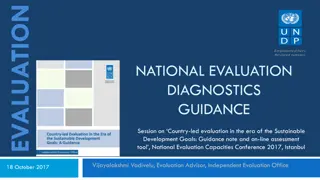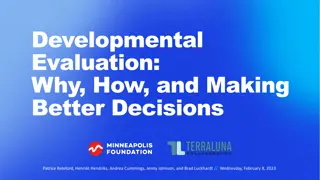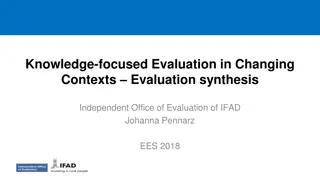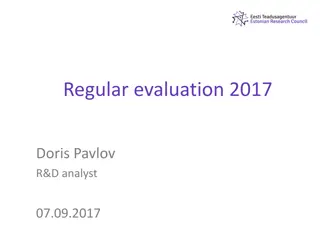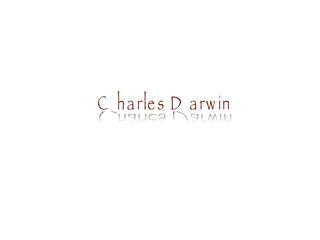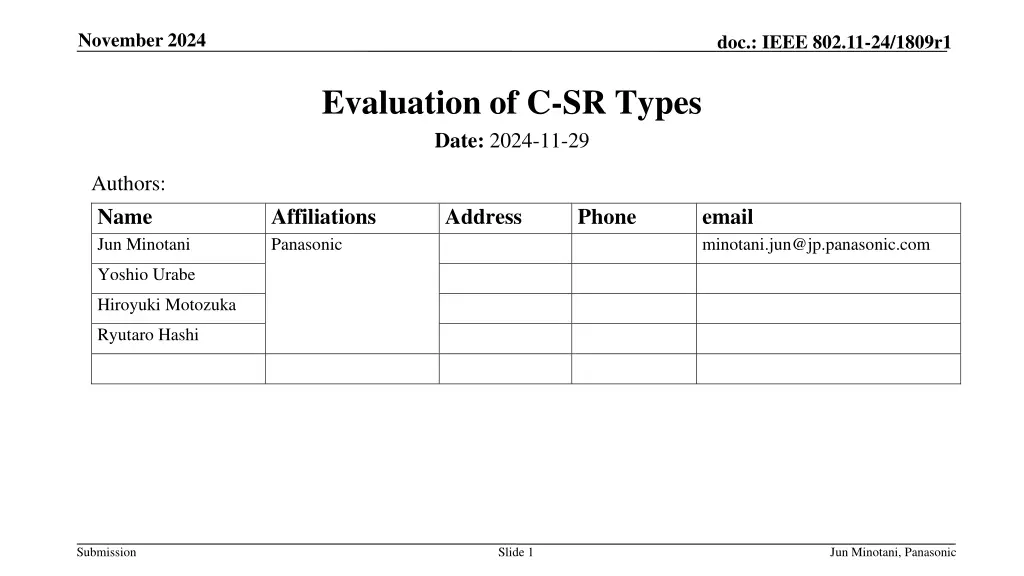
Evaluation of IEEE 802.11 C-SR Types in TGbn Networks
This document explores the evaluation of Coordinated Spatial Reuse (C-SR) types in IEEE 802.11 TGbn networks, focusing on performance and overhead considerations. The study covers optimal and one-way coordination, SIR measurement methods, and the assumed overhead of C-SR sequences in different coordination scenarios.
Download Presentation

Please find below an Image/Link to download the presentation.
The content on the website is provided AS IS for your information and personal use only. It may not be sold, licensed, or shared on other websites without obtaining consent from the author. If you encounter any issues during the download, it is possible that the publisher has removed the file from their server.
You are allowed to download the files provided on this website for personal or commercial use, subject to the condition that they are used lawfully. All files are the property of their respective owners.
The content on the website is provided AS IS for your information and personal use only. It may not be sold, licensed, or shared on other websites without obtaining consent from the author.
E N D
Presentation Transcript
November 2024 doc.: IEEE 802.11-24/1809r1 Evaluation of C-SR Types Date: 2024-11-29 Authors: Name Jun Minotani Affiliations Panasonic Address Phone email minotani.jun@jp.panasonic.com Yoshio Urabe Hiroyuki Motozuka Ryutaro Hashi Submission Slide 1 Jun Minotani, Panasonic
November 2024 doc.: IEEE 802.11-24/1809r1 Introduction Coordinated Spatial Reuse (C-SR) is one of the Multi-AP coordination schemes for TGbn In this contribution, we evaluated performance of each C-SR type including overhead of C-SR control signals Submission Slide 2 Jun Minotani, Panasonic
November 2024 doc.: IEEE 802.11-24/1809r1 Recap of C-SR types Optimal coordination Optimal coordination[1][2] Sharing AP determines Tx power for each AP by using measurement report of OBSS transmitted from associated non-AP STA and OBSS AP Prerequisites for maximizing throughput need to be considered One-way coordination[3] Sharing AP determines own Tx power without using measurement report transmitted from OBSS AP Shared AP determines own Tx power based on the transmit parameter of sharing AP Low overhead compared to optimal coordination One-way coordination Submission Slide 3 Jun Minotani, Panasonic
November 2024 doc.: IEEE 802.11-24/1809r1 How to obtain SIR in measurement phase Non-AP STAs measure RSSI from AP by using beacon signal AP requests non-AP STAs in its BSS to transmit measurement report including RSSI of each AP to calculate SIR of the non-AP STA Submission Slide 4 Jun Minotani, Panasonic
November 2024 doc.: IEEE 802.11-24/1809r1 Overhead assumption of C-SR C-SR sequence refer to [4] Beacon interval is 100[ms] in Measurement phase In our simulation environment, assuming that the three APs are equally to become TXOP owners, each AP can use a TXOP of 30[ms] before the next measurement phase Assuming the overhead of each signal below, each AP can send Multi-AP request ~ C-SR data 30 times which based on the most recent SIR measured in the measurement phase In optimal coordination C-SR, total time from Multi-AP request to C-SR data is approximately 1[ms] In one-way coordination C-SR, it can skip Multi-AP request and Multi-AP response, total time from Multi-AP Trigger to C-SR data is approximately 0.75[ms] Measurement phase Multi-AP Request Multi-AP Response Multi-AP Trigger C-SR data 1 [ms] 0.06 [ms] 0.14 [ms] 0.10 [ms] 0.65 [ms] Submission Slide 5 Jun Minotani, Panasonic
November 2024 doc.: IEEE 802.11-24/1809r1 Simulation setup Simulation Environment Layout One AP and one STA are placed in each 20[m] x 20[m] room STAs are deployed randomly (the number of drop patterns about 25,000) Sharing AP is fixed to AP1 Environment SIR map Parameter Link DL Frequency, Bandwidth 5[GHz], 80[MHz] Tx Power -10 ~ 20[dBm] Tx/Rx Antenna (AP, STA) = (4, 2) Stream 2 per STA Precoding SVD MCS index 0 ~ 13 Fading Model Model-D Noise Figure 7 [dB] Path loss model Eq.(1) Eq(1): Pathloss = 40.05 + 20 log10??/2.4 + 20 log10min ?,5 + ? > 5 35 log10?/5 + 10 ? ? = max(2D distance[m], 1) ?? = 5[GHz] ? = number of walls traversed Submission Slide 6 Jun Minotani, Panasonic
November 2024 doc.: IEEE 802.11-24/1809r1 Simulation result Our previous evaluations have shown that there are only a limited number of conditions for AP and non-AP STA placement that establish C-SR and are effective in improving throughput among all STA drops Therefore, we evaluated the CDF throughput of C-SR where the destination non-AP STA meets the high SIR condition (> 30[dB]) 1.0 0.9 0.8 optimal:SIR Optimal (Sharing AP: all STA drops, Shared AP: all STA drops) 0.7 optimal:Sharing AP SIR Optimal (Sharing AP: all STA drops, Shared AP: high SIR STA) 0.6 optimal:Shared AP SIR Optimal (Sharing AP: high SIR STA, Shared AP: all STA drops) CDF 0.5 optimal:Sharing Shared AP SIR Optimal (Sharing AP: high SIR STA,, Shared AP: high SIR STA,) 0.4 one-way:SIR One-way (Sharing AP: all STA drops, Shared AP: all STA drops) 0.3 one-way:Sharing AP SIR One-way (Sharing AP: all STA drops, Shared AP: high SIR STA) one-way:Shared AP SIR One-way (Sharing AP: high SIR STA, Shared AP: all STA drops) 0.2 one-way:Sharing Shared AP SIR One-way (Sharing AP: high SIR STA,, Shared AP: high SIR STA,) 0.1 0.0 0 500 1000 1500 2000 2500 3000 3500 System Throughput[Mbps] Submission Slide 7 Jun Minotani, Panasonic
November 2024 doc.: IEEE 802.11-24/1809r1 Observation While one-way coordination has a higher throughput than optimal coordination due to the difference in overhead of negotiation phase, the slope of the graph for one-way coordination is not steep. This is because one-way coordination includes many results with low throughput The throughput of C-SR for non-AP STAs that satisfy the STA condition increase in the following order, and the slope of the one-way coordination graph also becomes steeper High SIR STA at each APs > high SIR STA at Shared AP > high SIR STA at Sharing AP This is because low SIR non-AP STAs that can only transmit C-SR with low throughput are excluded Therefore, the STA condition regarding SIR is considered to be an important parameter in C-SR transmission Submission Slide 8 Jun Minotani, Panasonic
November 2024 doc.: IEEE 802.11-24/1809r1 Summary In this contribution, we evaluated performance of each C-SR type including C-SR control overhead We showed that one-way coordination C-SR achieves higher throughput than optimal coordination C-SR when considering the overhead of C-SR control signals transmitted during the beacon interval On the other hand, optimal coordination C-SR can achieve a more stable throughput than one-way coordination C-SR Throughput stability improves when the destination non-AP STAs of C-SR are high SIR Submission Slide 9 Jun Minotani, Panasonic
November 2024 doc.: IEEE 802.11-24/1809r1 References [1] Kanke Wu (Qualcomm), Performance of Coordinated Spatial Reuse, 23/1037r0, June, 2023 [2] Kosuke Aio (Sony), Evaluation of Coordinated Spatial Reuse - Follow Up, 23/1972r1, November, 2023 [3] Jonghun Han (Samsung), Coordinated Spatial Reuse: Focus on Downlink, 20/590r5, May, 2020 [4] Jun Minotani (Panasonic), Consideration on C-SR Types, 24/640r0, May, 2024 Submission Slide 10 Jun Minotani, Panasonic
November 2024 doc.: IEEE 802.11-24/1809r1 Straw poll Do you agree to add the following text to the TGbn SFD? - Support one-way coordination C-SR as a method of C-SR coordination - In the one-way coordination, Sharing AP determines own Tx power without using measurement report measured by OBSS STA Shared APs determine own Tx power based on the transmit parameter of sharing AP - Whether support for one-way coordination C-SR is mandatory or optional is TBD Submission Slide 11 Jun Minotani, Panasonic
November 2024 doc.: IEEE 802.11-24/1809r1 APPENDIX Submission Slide 12 Jun Minotani, Panasonic
November 2024 doc.: IEEE 802.11-24/1809r1 Overhead detail PPDU type Non-HT PPDU Non-HT PPDU EHT TB PPDU Non-HT PPDU EHT TB PPDU Non-HT PPDU EHT MU PPDU Non-HT PPDU Notes Beacon interval = 100[ms] Data rate other than C-SR data = MCS0 EHT PPDU parameters 4x EHT-LTF 3.2[us] GI Beacon Measurement repot poll Measurement report Multi-AP Request Multi-AP Response Multi-AP Trigger C-SR data ACK 46 [us] 56 [us] 139 [us] 62 [us] 136 [us] 67 [us] 580 [us] 53[us] OFDM symbol = 36 Submission Slide 13 Jun Minotani, Panasonic
November 2024 doc.: IEEE 802.11-24/1809r1 C-SR of STAs that meets other SIR condition 1.0 SIR condition of STA > 25[dB] 0.9 0.8 0.7 0.6 CDF all Optimal (Sharing AP: all STA drops, Shared AP: all STA drops) 0.5 all One-way (Sharing AP: all STA drops, Shared AP: all STA drops) 0.4 0.3 >25[dB] Optimal (Sharing AP: high SIR STA, Shared AP: all STA drops) 0.2 >25[dB] One-way (Sharing AP: high SIR STA, Shared AP: all STA drops) 0.1 0.0 0 500 1000 1500 2000 2500 3000 3500 System Throughput[Mbps] 1.0 1.0 0.9 0.9 0.8 0.8 0.7 0.7 0.6 0.6 CDF CDF 0.5 0.5 all Optimal (Sharing AP: all STA drops, Shared AP: all STA drops) all Optimal (Sharing AP: all STA drops, Shared AP: all STA drops) 0.4 0.4 all One-way (Sharing AP: all STA drops, Shared AP: all STA drops) all One-way (Sharing AP: all STA drops, Shared AP: all STA drops) 0.3 0.3 >25[dB] Optimal (Sharing AP: high SIR STA, Shared AP: high SIR STA) One-way (Sharing AP: high SIR STA, Shared AP: high SIR STA) 0.2 0.2 >25[dB] Optimal (Sharing AP: all STA drops, Shared AP: high SIR STA) 0.1 0.1 >25[dB] One-way (Sharing AP: all STA drops, Shared AP: high SIR STA) >25[dB] 0.0 0.0 0 500 1000 1500 2000 2500 3000 3500 0 500 1000 1500 2000 2500 3000 3500 System Throughput[Mbps] System Throughput[Mbps] Submission Slide 14 Jun Minotani, Panasonic








